- Established 1982 -HOME: www.hiltonpond.org
THIS WEEK at HILTON POND Subscribe for free to our award-winning nature newsletter (Back to Preceding Week; on to Next Week) |
All text, maps, charts & photos © Hilton Pond Center SWAMP MILKWEED AND We've mentioned before the butterfly population at Hilton Pond Center is relatively small, in part because diversity of potential host plants isn’t great. Before we arrived here in 1982 the entire 11 acres was under intense agricultural use for perhaps a hundred years, with plows repeatedly breaking the soil and/or livestock continuously grazing; these activities eliminated many native plant species such as herbaceous wildflowers and blooming shrubs that have not rebounded. Despite pressure from many species of invasive non-natives we battle constantly, a few wildflowers have returned--one being Swamp Milkweed, Asclepias incarnata (above). On the banks of Hilton Pond we host a couple of nice colonies of this native plant that likely sprouted from windblown seeds, and we delight in their pink inflorescence every August.
All text, maps, charts & photos © Hilton Pond Center Native North American milkweeds in general are well-known as important host plants for Monarch butterfly caterpillars, so each year we are on the lookout for black and orange adults flitting about. Although we've seen no local Monarchs for several years, our Swamp Milkweeds are visited frequently by adult Tiger Swallowtails (above) that suck up nectar but do not lay eggs. (Larvae of this swallowtail species dine on non-milkweed host plants that include Black Cherries and Tulip Trees.)
All text, maps, charts & photos © Hilton Pond Center We keep a close eye on our Swamp Milkweed patches, the biggest one visible from our computer desk in the Center's old farmhouse. This week we finally spotted a solitary Monarch butterfly (above) fluttering slowly from one milkweed flower cluster to the next. It looked tired and bedraggled, barely raising its antennae as it uncoiled its long proboscis to sample nectar.
All text, maps, charts & photos © Hilton Pond Center In dorsal view (above) this Monarch's wings were warn and bore many scratches where scales had been abraded. Despite our excitement over seeing this species after an absence of at last a half-decade, we knew there probably was no need to start looking for Monarch eggs on Swamp Milkweed foliage. The reason? As indicated by elongated black spots along the central veins on the butterfly's hindwings, this individual was a male and--unless we missed them--there were no egg-laying females this year with which he could have mated. (And considering his overall condition, we also doubt this particular male was one of those Monarchs heading out for a long migratory trip this fall.)
All text, maps, charts & photos © Hilton Pond Center We were both pleased and disappointed at seeing this solitary, worn out Monarch male, but he wasn't the only local insect sporting flashy black-and-orange attire at Hilton Pond Center. We also saw numerous Large Milkweed Bugs, Oncopeltus fasciatus, including one shown above extending its hypodermic-needle-like mouthparts into those Swamp Milkweed flowers. As members of the True Bug Order (Hemiptera, or "half-wing") these creatures have four wings--the hind pair fully membranous and transparent, the front pair with leathery bases and membranous apical ends.
All text, maps, charts & photos © Hilton Pond Center Although Large Milkweed Bug adults do take nectar, their nymphs use those sucking mouthparts to draw sap from milkweed stalks. Some years we see dozens of adults on our Swamp Milkweeds, followed by hundreds of ravenous nymphs. (Adult bugs show variety in coloration, as above. Males can be differentiated from females by looking at markings on the underside of the abdomen.) Incidentally, we found no Large Milkweed Bug nymphs on our milkweed in early August 2021--some years the plants are noticeably infested--so their reproductive season must come a little later.
All text, maps, charts & photos © Hilton Pond Center The next most obvious insects on Swamp Milkweed this week were several Great Black Wasps, Sphex pensylvanicus (above), whose common name is accurate and appropriate: They're up to an inch-and-a-half long and are entirely jet black, save for iridescent blue-black wings. Adult wasps probe milkweed flowers for nectar that fuels their hunt for grasshoppers and katydids. A female wasp paralyzes her prey items with 2-3 jabs of the stinger and hauls them to an underground burrow she's prepared in advance. There, the thread-waisted female lays her eggs on or under the immobilized but living prey that, in turn, provides fresh meat for her larvae when they hatch. The species is solitary, so there's no chance of humans getting swarmed; in fact, this docile wasp seldom stings anything except grasshoppers. Interestingly, when we were taking the photo above with our macro lens we were concentrating on focusing and framing the image. It wasn't until we looked at the enlarged photo on our computer that we noticed something quite surprising: Attached to the legs of the wasp were lots of little yellow wing-like structures we doubted were part of the wasp's anatomy.
All text, maps, charts & photos © Hilton Pond Center After deciding they weren't leg appendages or parasites, something clicked: Perhaps the yellow things were reproduction-related structures produced by the Swamp Milkweed flowers. Sure enough, a little research on milkweed plant anatomy told us members of this genus (Asclepias) exhibit a rare floristic phenomenon that also occurs with orchids: Each flower produces sticky pollen-bearing "pollinia"--packets that must be released by an insect and carried to the next flower for pollination.
All text, maps, charts & photos © Hilton Pond Center Alas, it takes a strong insect to pull its leg AND attached pollinia away from a special slit on the milkweed flower (see photo above), and then to carry the pollinia and insert them serendipitously into a corresponding slit on the next blossom. Great Black Wasps and large butterflies are powerful enough to do this and serve as milkweed's main pollinators; weak-footed Monarchs and smaller bees and wasps are not. In fact, sometimes the latter--especially European Honey Bees--get their feet caught in milkweed flower slits and are unable to extricate themselves. There they perish.
All text, maps, charts & photos © Hilton Pond Center A highly magnified view of the tip of a pollinator's leg (above) shows several attached pollinia--just like in our recent photos of the Great Black Wasp. The translucent yellow "wings" are actually paired sacs that enclose milkweed pollen needed for cross-fertilization. Assuming the pollinia find their way into that slit on a neighboring flower and there is successful cross-pollination, by late summer the milkweed produces a pod filled with plumed seeds. These scatter in the wind after the pod ages and eventually breaks open. In our experience at Hilton Pond Center this complex insect-based pollination scheme often meets with failure, such that a cluster of several dozen Swamp Milkweed flowers will produce only a few seed pods. One more thing about the Great Black Wasp shows in our enlarged image of its head (right).
All text, maps, charts & photos © Hilton Pond Center The Great Black Wasp was not the only big hymenopteran feasting on copious nectar in the Swamp Milkweed patch. In fact, the flowers hosted three times as many individuals of the somewhat smaller (1.25"), closely related Great Golden Digger Wasp, Sphex ichneumoneus (above). This species is also solitary and non-aggressive and takes similar but slightly smaller prey than the Great Black Wasp, once again as burrow provisions for their larvae. Such predatory behavior on grasshoppers and other big invertebrate herbivores should make both these digger wasp species the gardener's friends. Unfortunately, rather than letting the two wasps exercise natural, biological control of produce-eating grasshoppers, far too many homeowners employ chemical pesticides that indiscriminately kill both harmful AND beneficial insects--including native bees and digger wasps. (Note: A close look at the Great Golden Digger Wasps' front leg in the photo above reveals a couple of those yellow pollinia, indicating this species is also a Swamp Milkweed pollinator.)
All text, maps, charts & photos © Hilton Pond Center And speaking of bees, this week we saw just one representative from the Apidae ( Long-tongued Bee Family) nectaring on Swamp Milkweed with--naturally--its long tongue; it was a heavy-bodied Eastern Carpenter Bee, Xylocopa virginica (above), damp with dew. This individual had a tattered right forewing tip, suggesting it had been flying quite a bit this summer. Many observers confuse various Carpenter Bees with Bumble Bees, but the latter tend to have very fuzzy abdomens; the bee in our images does not. We also noticed from our photos Eastern Carpenter Bees have green compound eyes (below), compared to black ones typical of Bumble Bees.
All text, maps, charts & photos © Hilton Pond Center Homeowners often think of Carpenter Bees as an unwanted scourge because they tunnel into mostly unpainted wood on homes, decks, and storage buildings (especially log houses). An abundance of Carpenter Bees year after year can indeed damage wooden structures, but most folks are unaware they have a bee infestation until woodpeckers start working on wood surrounding the tunnels. People then go after the Carpenter Bees--and sometimes the woodpeckers--with a vengeance, spraying noxious chemicals and resorting to bee traps picked up at the local farmers' market.
All text, maps, charts & photos © Hilton Pond Center We sympathize with those homeowners but caution against a Carpenter Bee vendetta. All our North American pollinators are in big trouble due to habitat loss and overuse of insecticides, and it's apparent from our photo just above that Eastern Carpenter Bees are among those invaluable pollinators--at least for Swamp Milkweed. (See those tiny yellow pollinia on this bee's front and middle right legs in the photo above? That's pretty good evidence!) Swamp Milkweed is an amazing native plant and its co-evolved insects from digger wasps to milkweed bugs are all part of the big picture, whether they're sapsuckers or vitally important pollinators. It would do humans well to study the intricate relationships within Hilton Pond Center's mini-ecosystem described above--or any of countless others--and to do a better job taking care of the Earth as a whole. After all, Swamp Milkweed and Carpenter Bees and Great Black Wasps were here long before humans, and in many ways have more of a right to the world than we do. All text, maps, charts & photos © Hilton Pond Center BIRD BANDING MILESTONE
All text, maps, charts & photos © Hilton Pond Center Shortly after noon on 14 Aug 2021 we extracted an immature Blue-gray Gnatcatcher (that's it above) from one of our mist nets at Hilton Pond Center. It was the fourth BGGN of the year and the 147th in 40 years here. More significantly, it was our 74,000th bird banded locally since 1982, from 127 species captured. And the count continues! All text, maps, charts & photos © Hilton Pond Center NO MORE PUCKER-UP
All text, maps, charts & photos © Hilton Pond Center Tornadic weather on 17 Aug 2021 that affected locations in the South Carolina Upstate passed by Hilton Pond Center with little impact, save a big branch from an Eastern Redbud, Cercis canadensis, that snapped and fell harmlessly on the driveway to our old farmhouse. The next morning, however, we were distressed to find strong winds had stripped hundreds of unripe fruits from a towering Common Persimmon, Diospyros virginiana. All text, maps, charts & photos © Hilton Pond Center AN UNCOMMON LOCAL WARBLER
All text, maps, charts & photos © Hilton Pond Center We ran a few mist nets on 21 August 2021 and caught something that has been rare here through the years: A Kentucky Warbler (KEWA, above)--just our 22nd banded since 1982 at Hilton Pond Center. This short-tailed warbler, an immature of undetermined sex, was about as yellow as yellow can get, from throat to breast to undertail coverts; there was even a yellow swoosh around the top and back of the eye. Although not visible in our photo, the legs and toes are noticeably pink. (NOTE: Adult males have a black cap and "sideburns.") KEWA breed in the eastern U.S. to the edge of the Great Plains and as far north as southern Pennsylvania, spending our cold months along the Caribbean coast from southern Mexico to Panama. In South Carolina they occur statewide, primarily in deciduous forests where they build a ground nest in a dense weed patch or hidden at the base of a shrub. Presence of the young bird we captured this week suggests Kentucky Warblers breed at or near the Center, although it could have been a very early migrant. (We have found no KEWA nests locally, nor have we banded females with a brood patch.) All text, maps, charts & photos © Hilton Pond Center HUMMINGBIRD TALLIES
All text, maps, charts & photos © Hilton Pond Center At Hilton Pond Center we don't have as many Ruby-throated Hummingbirds (RTHU) as some folks do, but on 22 August 2021 we banded an young male that was our 145th of the season. This is the second-earliest date in 38 years to reach that number. (NOTE: We had 170 by this date in 2016, which turned out to be our all-time best year for banding RTHU with 373--more than twice our annual average of 180.) We anticipate quite a few more hummers this year as August and September unfold. Please remember that all ruby-throats at the Center are marked with temporary green dye on the lower throat (see photo above of adult female). This minimizes recapture of banded RTHU in our pull-string and other bander-triggered traps and also provides a mark that folks elsewhere can see at their feeders. If you spot a color-marked hummer, try to get a photo and let us know as soon as possible at RESEARCH. Documented reports will help add to our knowledge of Ruby-throated Hummingbird fall migration. All text, maps, charts & photos © Hilton Pond Center HILTON POND SUNSETS "Never trust a person too lazy to get up for sunrise
All text, maps, charts & photos © Hilton Pond Center Sunset over Hilton Pond (above), 13 August 2021
All text, maps, charts & photos © Hilton Pond Center Sunset over Hilton Pond (above), 21 August 2021 Photoshop image post-processing for this page employs
Checks also can be sent to Hilton Pond Center at: All contributions are tax-deductible on your Don't forget to scroll down for Nature Notes & Photos, |
|---|
|
"This Week at Hilton Pond" is written and photographed by Dr. Bill Hilton Jr., executive director of Hilton Pond Center for Piedmont Natural History
|
|
|
Please refer "This Week at Hilton Pond" to others by clicking on this button: |
|

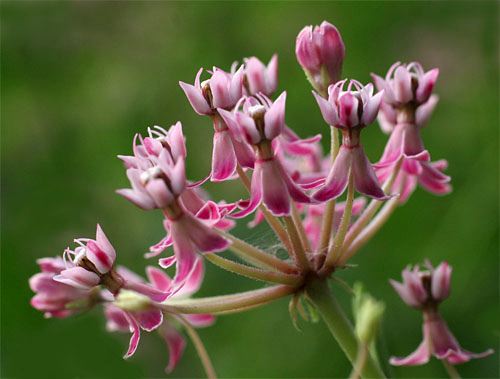
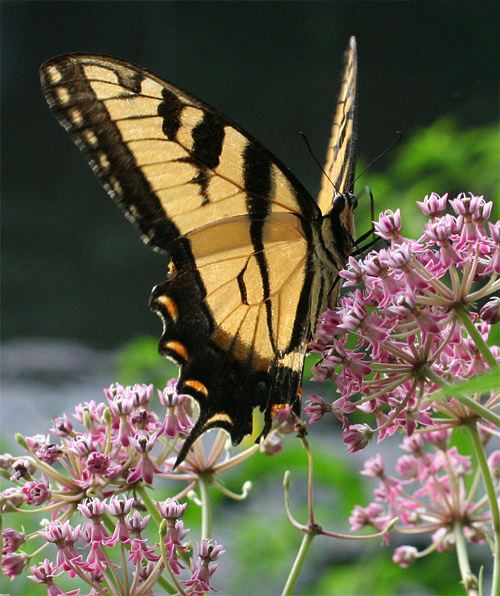



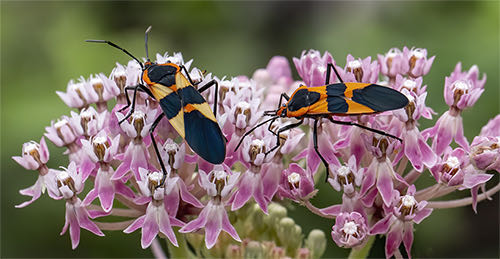
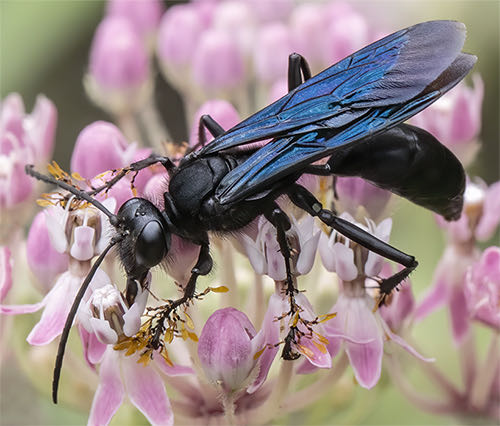
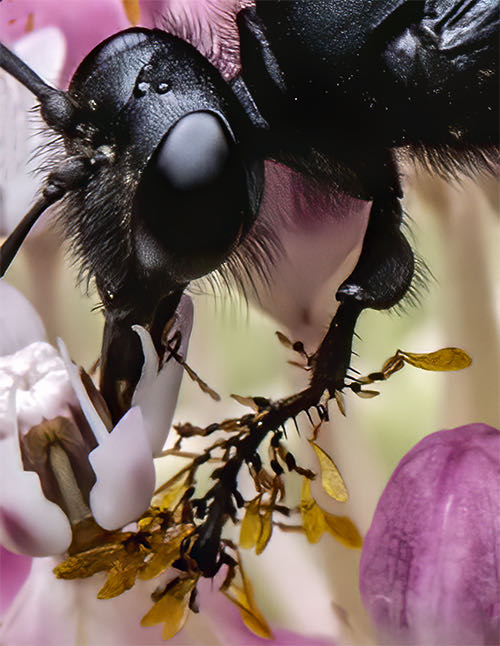


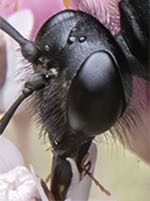 As the adult wasp inserts its mouthparts deep into a Swamp Milkweed flower in search of energy-rich nectar, it is undoubtedly sensing its surroundings with paired antennae and two large multi-faceted compound eyes. But look between those big black eyes and you'll see three tiny bumps in a V-shape. These are "ocelli," simple eyes that focus light through one lens each; they tell the insect where it is with respect to the Sun and enable precise navigation. In the case of the Great Black Wasp, its ocelli will help lead the female back to a subterranean burrow that serves as nursery for her developing larvae.
As the adult wasp inserts its mouthparts deep into a Swamp Milkweed flower in search of energy-rich nectar, it is undoubtedly sensing its surroundings with paired antennae and two large multi-faceted compound eyes. But look between those big black eyes and you'll see three tiny bumps in a V-shape. These are "ocelli," simple eyes that focus light through one lens each; they tell the insect where it is with respect to the Sun and enable precise navigation. In the case of the Great Black Wasp, its ocelli will help lead the female back to a subterranean burrow that serves as nursery for her developing larvae. 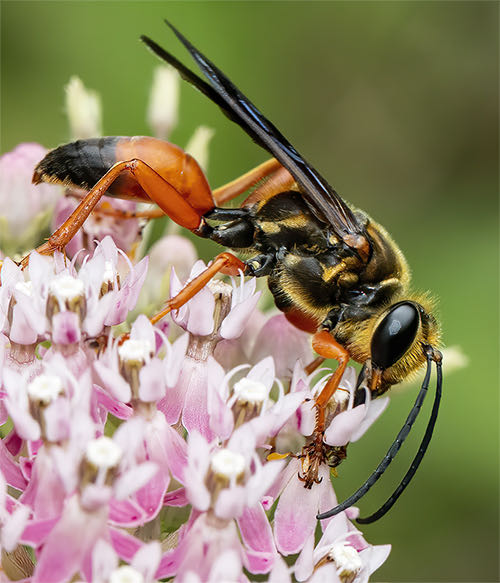
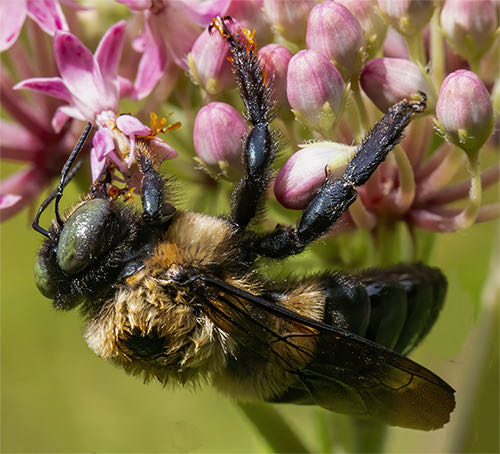
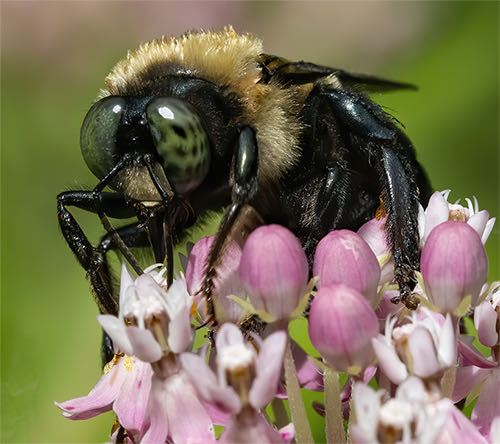
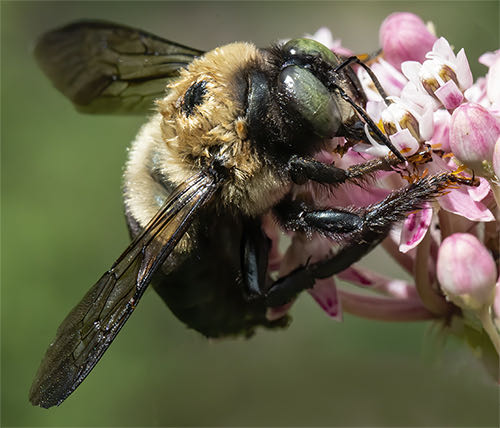
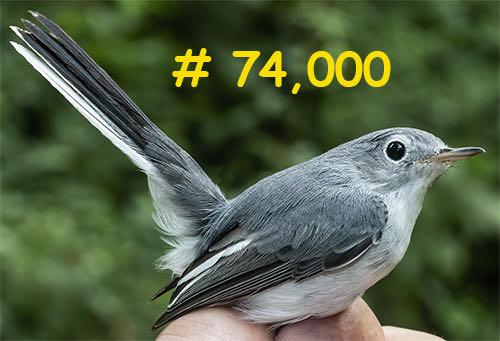

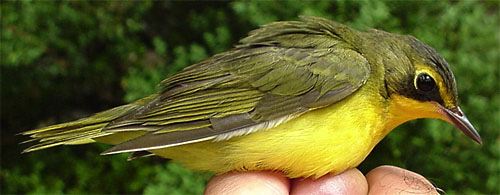
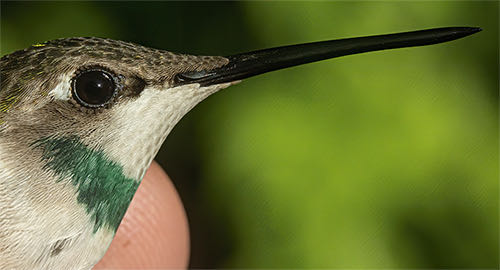
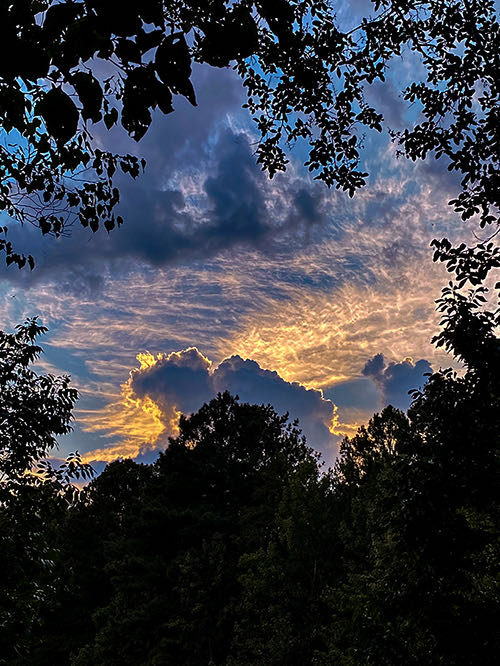
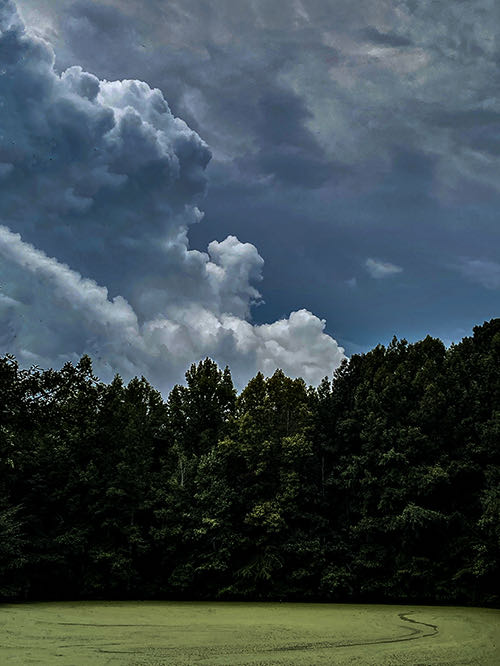










 Please report your spring, summer &
Please report your spring, summer &